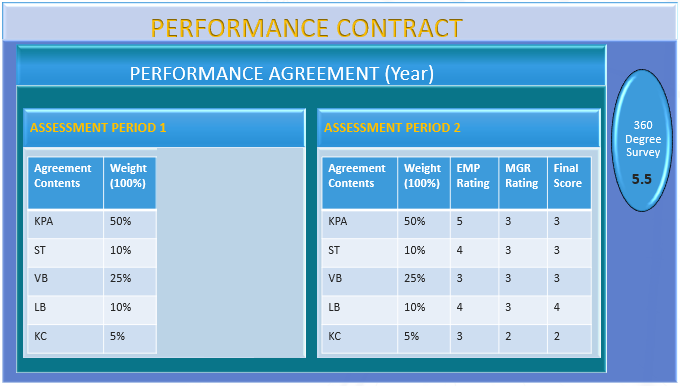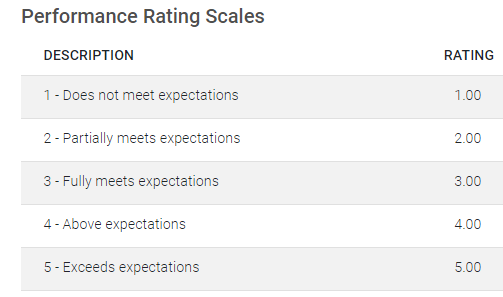Glossary
The Signify performance management module allows the use of field aliases, meaning you can rename certain system objects to match the terminology used in your company. Find here a list of standard terminology and the meaning Signify attaches to each.
Contract, Performance Agreement and Assessment/Review Period
The best way to explain the Signify definition of the three interconnected concepts of
- Contract,
- Performance Agreement, and
- Assessment Period (also called a review period),
is by referring to the following diagram.
There are one or more assessment periods (also called review periods) in a performance agreement. An employee's performance agreement contains his/her objectives. If other components (e.g. a 360 degree survey) are added to the employee's performance agreement, we refer to the combination as a performance contract. Thus, when referring to a performance contract it implies the performance agreement, but the performance agreement does not include the additional components - it only refers to the performance objectives.
Performance Year / Cycle
A performance year, or cycle, usually lasts for 12 months. A company's performance cycle could e.g. run from January up to December, or from July to June of the next year. One of the considerations in deciding your performance cycle might be to synchronise it with your salary increases negotiations.
Assessment Frequency
A performance year is usually divided into one or more time periods - called review or assessment periods. The number of assessment periods in a performance year is called the assessment frequency. See below for the most used assessment frequencies.
- Annual (there will be 1 review or assessment, 12 months in duration)
- Bi-annual (2 reviews, usually 6 months each)
- Quarterly (4 reviews, usually 3 months in each)
Review Survey
A performance agreement is used to set performance objectives for a period. Occasionally companies combine a performance agreement with a review survey, also called a 360 degree evaluation, in which more general, company-related behaviours are measured.
Contract Phase Statuses
A performance contract follows a process as it goes between an employee and a manager for submission, approval etc. See below the main contract phases you can expect to see on reports and the Performance Management Dashboard.
| CONTRACT PHASE | CONTRACT STATUS | MEANING TO THE EMPLOYEE |
| Contract | Performance Agreement Allocated | A performance agreement was created for the employee but no objectives were loaded yet. |
|
Objective Setting
(for each review period in the agreement) |
Objective Setting Started | Some objectives were loaded, either by the employee or the manager. |
| Objective Setting Completed - Employee | Objectives were loaded and the employee submitted the agreement. | |
| Objective Setting Completed - Manager |
The manager considered the submitted objectives, may have had a discussion with the employee, made changes to the objectives as needed and approved the agreement. The rating fields for employee and manager are now available. |
|
|
Review
(for each review period in the agreement) |
Review Started | The agreement was opened in the review phase, but the employee or manager ratings were not submitted yet. |
| Review Completed - Employee | The employee completed his/her self-review and submitted the rated agreement to the manager. | |
| Review Completed - Manager | The manager completed their personal rating of the employee's objectives, considered the employee's self-rated objectives, may have had a discussion with the employee, provided the final objective scores and approved the rated agreement. | |
| Review Survey | Review Survey | If part of the contract, the Review Survey Score is provided, usually by the Performance Administrator. |
| Contract | Finalised | The agreement and the review survey parts of the contracts have been completed and submitted or approved by manager and employee. |
Objective
An objective is a goal to be achieved. In Signify a KPA's KPI, a Stretch Target KPI, a Company Value, a Leadership Behaviour and a Key Competency are all called objectives, or goals, which an employee should achieve during the course of a performance year, and against which the employee will be measured .
Objective Setting (Phase)
In the beginning of a performance year, for a certain time period, the employee and their manager will engage to determine what the appropriate objectives will be for the employee's performance agreement. That is, what performance goals are set for the employee. This is called the objective setting phase of a performance agreement.
Rating (Phase)
Towards the end of an assessment (or review) period in a performance year, the employee and their manager will engage to discuss the employee's self-review ratings, the manager's personal review ratings of the employee's performance, and then discuss the final ratings for each objective. This is called the rating phase of a performance agreement.
Section Weight
A performance agreement consists of one to 5 different sections: Key Performance Areas, Stretch Targets, Company Values, Leadership Behaviours and Key Competencies. Each of these carry a weight to indicate its relative importance to the agreement. In the image below the Key Performance Area's section weight is 50%. Simply put, if you get an average score of 4 (out of 5) for the KPA section, its contribution to your overall agreement score will be 50% x 4 = 2.
See below typical section weights for an agreement. Note that section weights must always add up to 100%.
| SECTION | TYPICAL SECTION WEIGHT |
| Key Performance Areas | 70% |
| Stretch Targets | 10% |
| Company Values | 5% |
| Leadership Behaviours | 5% |
| Key Competencies | 10% |
| TOTAL | 100% |
Rating / Score
In the beginning of a performance year, a manager and employee discuss the employee's objectives for the year ahead. At the end of each review or assessment period (of which there could be 1 or more in a year) there follows a review. During the review the employee provides a personal rating or score for each of his/her objectives. This is only seen by the manager once the employee submits his/her ratings. The manager also provides a personal rating for each of the employee's objectives - also not immediately seen by the employee. Each section could potentially have its own rating scale, but usually they are kept the same. See below for an example of a typical rating scale.
During a joint discussion the manager and employee talk about their personal ratings, and especially any rating discrepancies. The manager provides a final rating or score for each objective and this becomes the final rating for the employee's review period.
Personal Development Plan (PDP)
Perspective / Pillar
Perspectives are categories used to group KPAs together and has its origin in the Balanced Scorecard approach to performance management. Typical examples of perspectives are:
- Financial perspective
- Customer perspective
- Internal process perspective
- Learning & growth perspective
If the system is configured as such, a user must select a perspective before any KPAs can be added. The perspective categorisation can be disabled by a setting which means only KPAs and KPIs are then required in the Key Performance Area and Stretch Targets sections. Some people prefer to use the word 'pillars'.
Key Performance Area (KPA)
Key Performance Areas refer to the areas within the business for which a person is responsible e.g. Process Improvement, Safety and Health, Security, etc. A KPA is further defined by one or more Key Performance Indicators (KPI). Refer to Key Performance Indicators for further examples.
Key Performance Indicators (KPI)
A Key Performance Indicator is a type of performance measurement that acts as a compass, helping you understand how you are performing towards strategic goals or objectives. To be effective, a KPI must be well-defined, quantifiable and be crucial to achieving your goal. See below for examples of how a KPI can further define a KPA.
|
KEY PERFORMANCE AREA (Area of work) |
KEY PERFORMANCE INDICATOR (Outcome/impact to be achieved) |
|
Customer complaints |
Reduction in time response to resolve complaints, per quarter |
|
Cost effective procurement |
Reduction on cost spend on items sourced per supplier, per year |
Key Competencies
Stretch Targets
Leadership Behaviours
Values and Behaviours / Company Values
Employee / User
Manager / Performance Manager / Line Manager
Pre-moderation Rating / Final Rating
Moderation / Calibration
Submit vs. Approve vs. Modify
Dual Approval
Rating Scale
Scoring / Rating
Check-in



